Fitzgerald A.E. Electric Machinery
Подождите немного. Документ загружается.

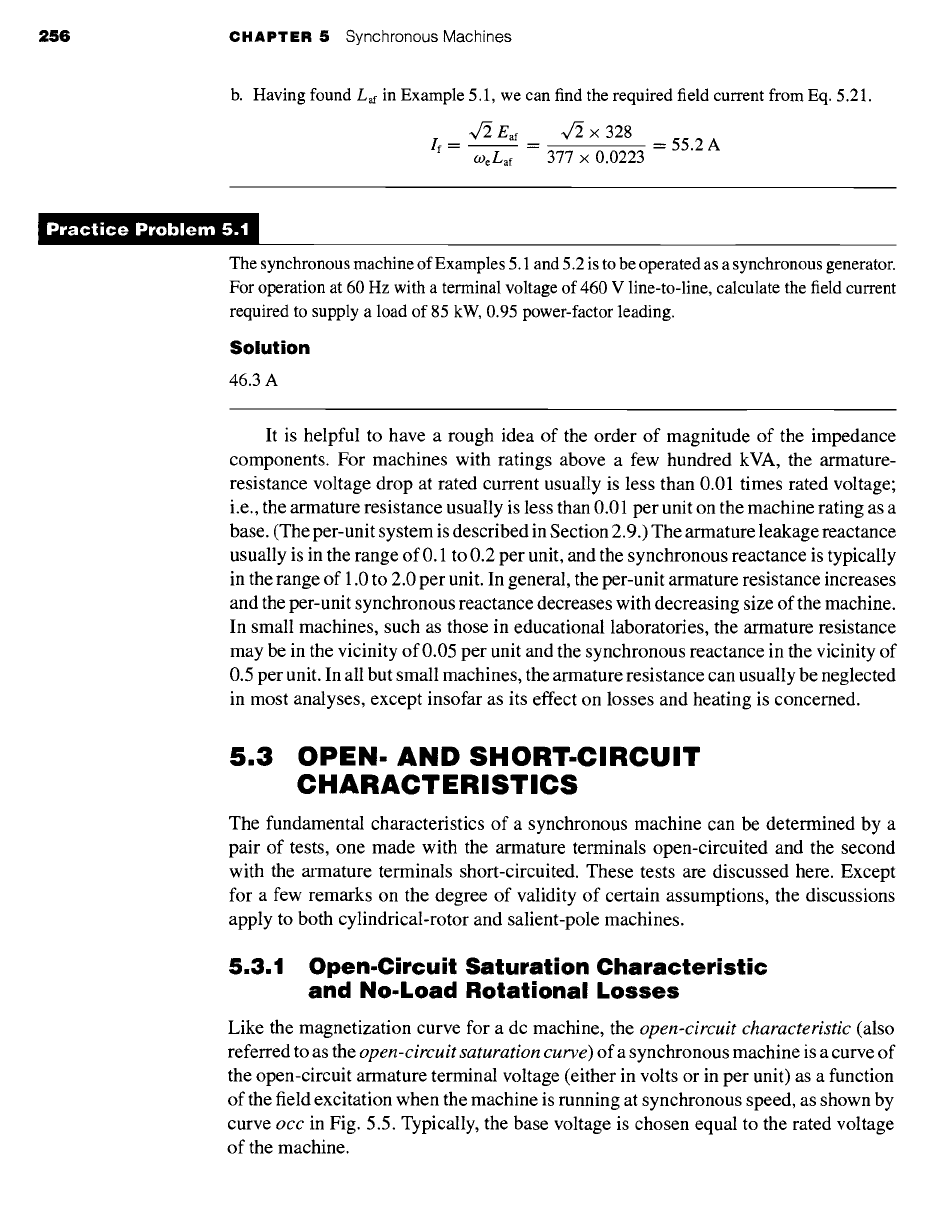
256 CHAPTER 5 Synchronous Machines
b. Having found
Laf
in Example 5.1, we can find the required field current from Eq. 5.21.
E,e ~/2 × 328
If = = = 55.2 A
~oeLae 377 × 0.0223
The synchronous machine of Examples 5.1 and 5.2 is to be operated as a synchronous generator.
For operation at 60 Hz with a terminal voltage of 460 V line-to-line, calculate the field current
required to supply a load of 85 kW, 0.95 power-factor leading.
Solution
46.3 A
It is helpful to have a rough idea of the order of magnitude of the impedance
components. For machines with ratings above a few hundred kVA, the armature-
resistance voltage drop at rated current usually is less than 0.01 times rated voltage;
i.e., the armature resistance usually is less than 0.01 per unit on the machine rating as a
base. (The per-unit system is described in Section 2.9.) The armature leakage reactance
usually is in the range of 0.1 to 0.2 per unit, and the synchronous reactance is typically
in the range of 1.0 to 2.0 per unit. In general, the per-unit armature resistance increases
and the per-unit synchronous reactance decreases with decreasing size of the machine.
In small machines, such as those in educational laboratories, the armature resistance
may be in the vicinity of 0.05 per unit and the synchronous reactance in the vicinity of
0.5 per unit. In all but small machines, the armature resistance can usually be neglected
in most analyses, except insofar as its effect on losses and heating is concerned.
5.3 OPEN- AND SHORT-CIRCUIT
CHARACTERISTICS
The fundamental characteristics of a synchronous machine can be determined by a
pair of tests, one made with the armature terminals open-circuited and the second
with the armature terminals short-circuited. These tests are discussed here. Except
for a few remarks on the degree of validity of certain assumptions, the discussions
apply to both cylindrical-rotor and salient-pole machines.
5.3.1
Open.Circuit Saturation Characteristic
and No-Load Rotational Losses
Like the magnetization curve for a dc machine, the
open-circuit characteristic
(also
referred to as the
open-circuit saturation curve)
of a synchronous machine is a curve of
the open-circuit armature terminal voltage (either in volts or in per unit) as a function
of the field excitation when the machine is running at synchronous speed, as shown by
curve
occ
in Fig. 5.5. Typically, the base voltage is chosen equal to the rated voltage
of the machine.

5.3
Open- and Short-Circuit Characteristics
257
o
Rated
voltage
Air-gap line/
_ y OCC
I I
I I
I I
I I
I I
I I
I I
I I
I I
I I
b a
Field current
Figure 5.5
Open-circuit characteristic
of a synchronous machine.
The open-circuit characteristic represents the relation between the space-
fundamental component of the air-gap flux and the mmf acting on the magnetic
circuit when the field winding constitutes the only mmf source. Note that the effects
of magnetic saturation can be clearly seen; the characteristic bends downward with
increasing field current as saturation of the magnetic material increases the reluctance
of the flux paths in the machine and reduces the effectiveness of the field current in
producing magnetic flux. As can be seen from Fig. 5.5, the open-circuit characteristic
is initially linear as the field current is increased from zero. This portion of the curve
(and its linear extension for higher values of field current) is known as the
air-gap
line.
It represents the machine open-circuit voltage characteristic corresponding to
unsaturated operation. Deviations of the actual open-circuit characteristic from this
curve are a measure of the degree of saturation in the machine.
Note that with the machine armature winding open-circuited, the terminal volt-
age is equal to the generated voltage
Eaf.
Thus the open-circuit characteristic is a
measurement of the relationship between the field current If and Eaf. It can therefore
provide a direct measurement of the field-to-armature mutual inductance Laf.
An open-circuit test performed on a three-phase, 60-Hz synchronous generator shows that the
rated open-circuit voltage of 13.8 kV is produced by a field current of 318 A. Extrapolation
of the air-gap line from a complete set of measurements on the machine shows that the field-
current corresponding to 13.8 kV on the air-gap line is 263 A. Calculate the saturated and
unsaturated values of Laf.
II
Solution
From Eq. 5.21,
Laf
is found from
Za f --
~/~ Eaf
EXAMPLE 5.3
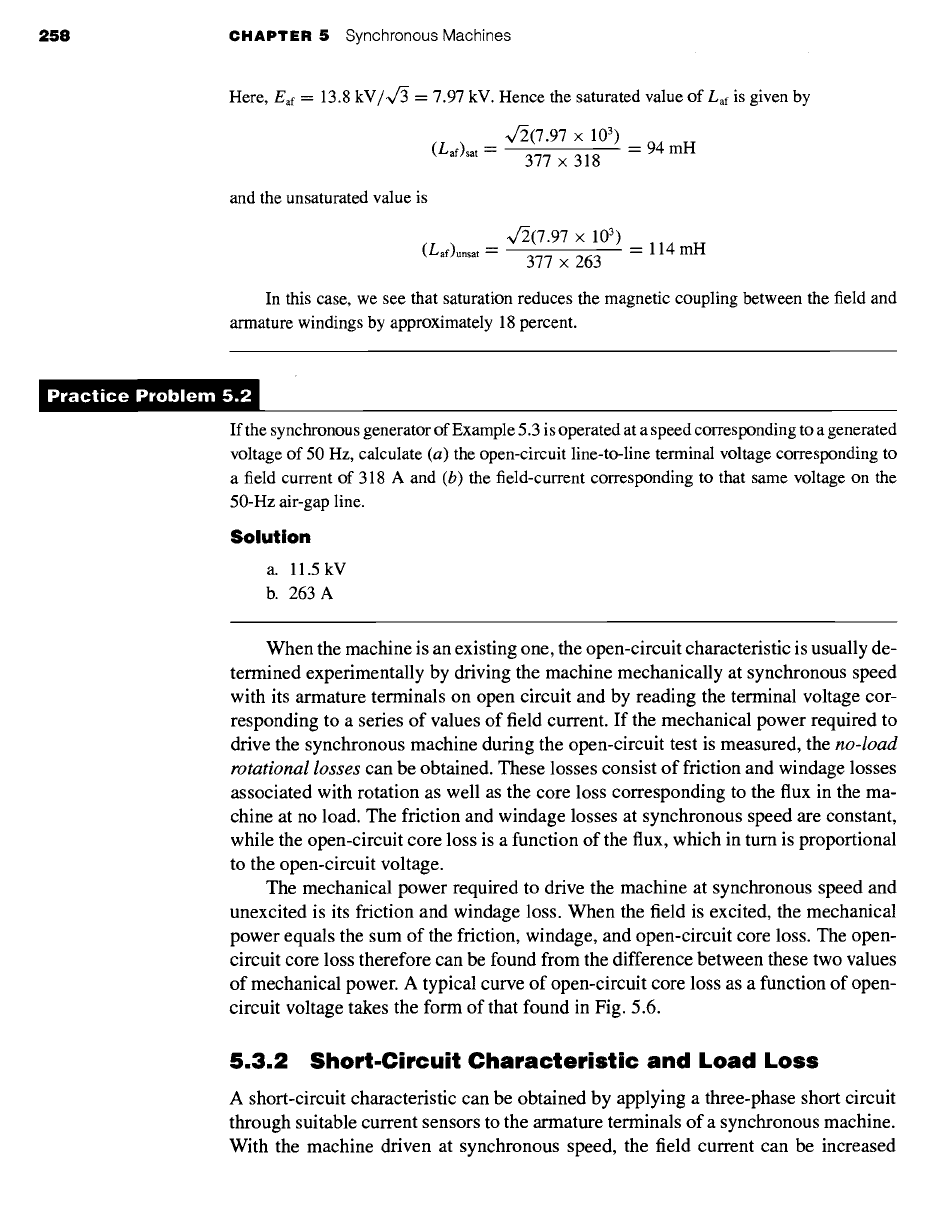
258 CHAPTER
5 Synchronous Machines
Here, Ear --
13.8 kV/~/3 = 7.97 kV. Hence the saturated value of
Laf
is given by
Vc2(7.97
x 10 3)
(Laf)sat -- :
94 mH
377 x 318
and the unsaturated value is
~/2(7.97
x 10 3)
(Laf)
....
t -- ----- 114 mH
377 x 263
In this case, we see that saturation reduces the magnetic coupling between the field and
armature windings by approximately 18 percent.
If the synchronous generator of Example 5.3 is operated at a speed corresponding to a generated
voltage of 50 Hz, calculate (a) the open-circuit line-to-line terminal voltage corresponding to
a field current of 318 A and (b) the field-current corresponding to that same voltage on the
50-Hz air-gap line.
Solution
a. 11.5 kV
b. 263A
When the machine is an existing one, the open-circuit characteristic is usually de-
termined experimentally by driving the machine mechanically at synchronous speed
with its armature terminals on open circuit and by reading the terminal voltage cor-
responding to a series of values of field current. If the mechanical power required to
drive the synchronous machine during the open-circuit test is measured, the
no-load
rotational losses
can be obtained. These losses consist of friction and windage losses
associated with rotation as well as the core loss corresponding to the flux in the ma-
chine at no load. The friction and windage losses at synchronous speed are constant,
while the open-circuit core loss is a function of the flux, which in turn is proportional
to the open-circuit voltage.
The mechanical power required to drive the machine at synchronous speed and
unexcited is its friction and windage loss. When the field is excited, the mechanical
power equals the sum of the friction, windage, and open-circuit core loss. The open-
circuit core loss therefore can be found from the difference between these two values
of mechanical power. A typical curve of open-circuit core loss as a function of open-
circuit voltage takes the form of that found in Fig. 5.6.
5.3.2 Short.Circuit Characteristic and Load Loss
A short-circuit characteristic can be obtained by applying a three-phase short circuit
through suitable current sensors to the armature terminals of a synchronous machine.
With the machine driven at synchronous speed, the field current can be increased
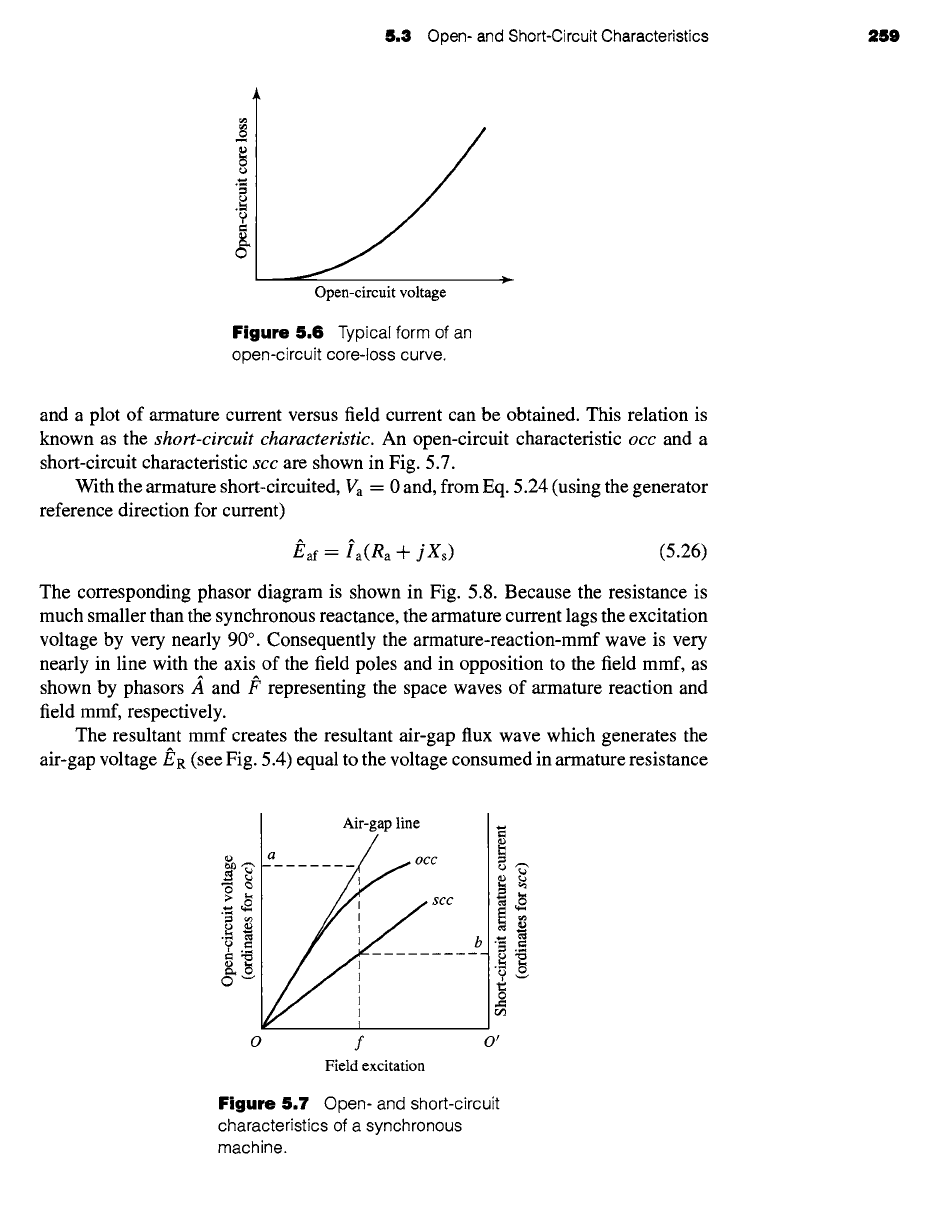
5.3
Open- and Short-Circuit Characteristics 259
r~
°,-q
?
r
Open-circuit voltage
Figure
5.6 Typical form of an
open-circuit core-loss curve.
and a plot of armature current versus field current can be obtained. This relation is
known as the short-circuit characteristic. An open-circuit characteristic occ and a
short-circuit characteristic scc are shown in Fig. 5.7.
With the armature short-circuited, Va = 0 and, from Eq. 5.24 (using the generator
reference direction for current)
J~af = ]a(Ra -~- jXs) (5.26)
The corresponding phasor diagram is shown in Fig. 5.8. Because the resistance is
much smaller than the synchronous reactance, the armature current lags the excitation
voltage by very nearly 90 °. Consequently the armature-reaction-mmf wave is very
nearly in line with the axis of the field poles and in opposition to the field mmf, as
shown by phasors ,4 and P representing the space waves of armature reaction and
field mmf, respectively.
The resultant mmf creates the resultant air-gap flux wave which generates the
air-gap voltage/~R (see Fig. 5.4) equal to the voltage consumed in armature resistance
.,..~
r~
Air-gap line
a. ~ occ
// I / scc
/',,j
f
Field excitation
0 O'
Figure
5.7 Open- and short-circuit
characteristics of a synchronous
machine.

260
CHAPTER 5 Synchronous Machines
y~
k ~"- jXsia
jXalia
ia
f
v
,I
4,f
I
Axis of
field
Figure
5.8 Phasor diagram for short-circuit
conditions.
Ra
and leakage reactance
Xal; as
an equation,
/~R = la(Ra -k- jXal) (5.27)
In many synchronous machines the armature resistance is negligible, and the
leakage reactance is between 0.10 and 0.20 per unit; a representative value is about
0.15 per unit. That is, at rated armature current the leakage reactance voltage drop is
about 0.15 per unit. From Eq. 5.27, therefore, the air-gap voltage at rated armature
current on short circuit is about 0.15 per unit; i.e., the resultant air-gap flux is only
about 0.15 times its normal voltage value. Consequently, the machine is operating
in an unsaturated condition. The short-circuit armature current, therefore, is directly
proportional to the field current over the range from zero to well above rated armature
current; it is thus a straight line as can be seen in Fig. 5.7.
The unsaturated synchronous reactance (corresponding to unsaturated operat-
ing conditions within the machine) can be found from the open- and short-circuit
characteristics. At any convenient field excitation, such as Of in Fig. 5.7, the arma-
ture current on short circuit is O'b, and the unsaturated generated voltage for the same
field current corresponds to O a, as read from the air-gap line. Note that the voltage
on the air-gap line should be used because the machine is assumed to be operating in
an unsaturated condition. If the line-to-neutral voltage corresponding to O a is Va, ag
and the armature current per phase corresponding to O'b is la, sc, then from Eq. 5.26,
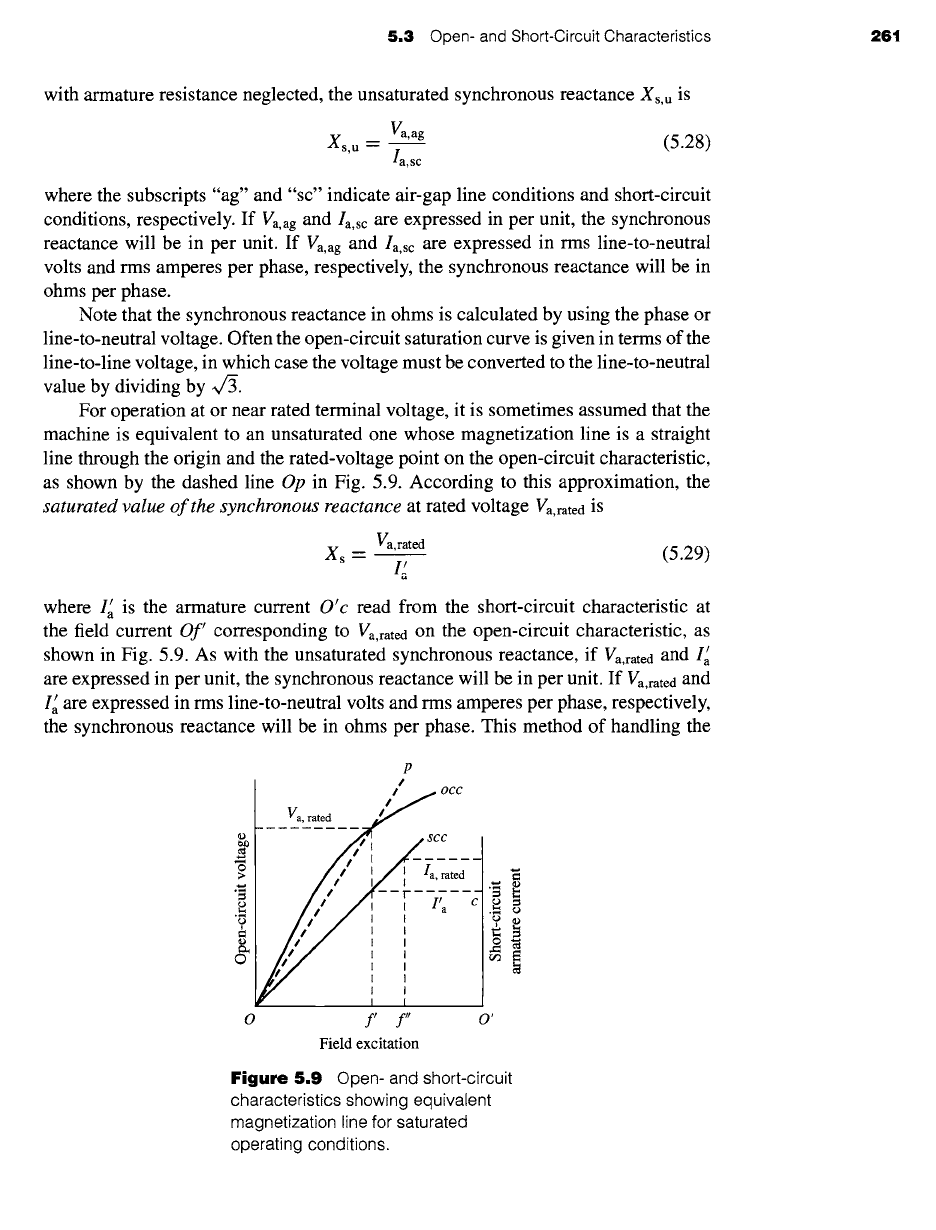
5.3 Open- and Short-Circuit Characteristics 261
with armature resistance neglected, the unsaturated synchronous reactance Xs,u is
Wa, ag (5.28)
Xs,u- la, sc
where the subscripts "ag" and "sc" indicate air-gap line conditions and short-circuit
conditions, respectively. If Va,ag and Ia, sc are expressed in per unit, the synchronous
reactance will be in per unit. If Va, ag and la, sc are expressed in rms line-to-neutral
volts and rms amperes per phase, respectively, the synchronous reactance will be in
ohms per phase.
Note that the synchronous reactance in ohms is calculated by using the phase or
line-to-neutral voltage. Often the open-circuit saturation curve is given in terms of the
line-to-line voltage, in which case the voltage must be converted to the line-to-neutral
value by dividing by ~/-3.
For operation at or near rated terminal voltage, it is sometimes assumed that the
machine is equivalent to an unsaturated one whose magnetization line is a straight
line through the origin and the rated-voltage point on the open-circuit characteristic,
as shown by the dashed line
Op
in Fig. 5.9. According to this approximation, the
saturated value of the synchronous reactance
at rated voltage
Va,rated is
Va,rated
Xs = (5.29)
E
tt
where I a' is the armature current
Otc
read from the short-circuit characteristic at
the field current
Of'
corresponding
to
Va,rated on the open-circuit characteristic, as
shown in Fig. 5.9. As with the unsaturated synchronous reactance, if
Va,rated
and I a'
are expressed in per unit, the synchronous reactance will be in per unit. If
Va,rated
and
I a' are expressed in rms line-to-neutral volts and rms amperes per phase, respectively,
the synchronous reactance will be in ohms per phase. This method of handling the
p
/
11 j
OCC
Va, rated I,~
..... ,4,'~";-
X' i/- ~a' rated
IS¢C +~
,~ #" I .....
, --r T---.~
"~
All ~--~
7 a C "~ ~
©
0
f' f"
O'
Field excitation
Figure 5.9
open- and short-circuit
characteristics showing equivalent
magnetization line for saturated
operating conditions.

262
CHAPTER 5 Synchronous Machines
effects of saturation, which assumes that the effects of saturation can be described
by a single value of saturated reactance, usually gives satisfactory results when great
accuracy is not required.
The
short-circuit ratio
(SCR) is defined as the ratio of the field current required
for rated voltage on open circuit to the field current required for rated armature current
on short circuit. That is, in Fig. 5.9
Of'
SCR = (5.30)
Of"
It can be shown that the SCR is the reciprocal of the per-unit value of the saturated
synchronous reactance found from Eq. 5.29. It is common to refer to the field current
Of'
required to achieve rated-open-circuit voltage as AFNL
(Amperes FieldNo Load)
and the field current
Of"
required to achieve rated-short-circuit current as AFSC
(Amperes Field Short Circuit).
Thus, the short-circuit ratio can also be written as
AFNL
SCR = (5.31)
AFSC
!XAMPLE 5.~
The following data are taken from the open- and short-circuit characteristics of a 45-kVA, three-
phase, Y-connected, 220-V (line-to-line), six-pole, 60-Hz synchronous machine. From the
open-circuit characteristic:
Line-to-line voltage = 220 V Field current = 2.84 A
From the short-circuit characteristic:
Armature current, A 118 152
Field current, A 2.20 2.84
From the air-gap line:
Field current = 2.20 A Line-to-line voltage = 202 V
Compute the unsaturated value of the synchronous reactance, its saturated value at rated
voltage in accordance with Eq. 5.29, and the short-circuit ratio. Express the synchronous
reactance in ohms per phase and in per unit on the machine rating as a base.
II Solution
At a field current of 2.20 A the line-to-neutral voltage on the air-gap line is
202
Va.ag = ~ = 116.7V
and for the same field current the armature current on short circuit is
/.,sc = l18A
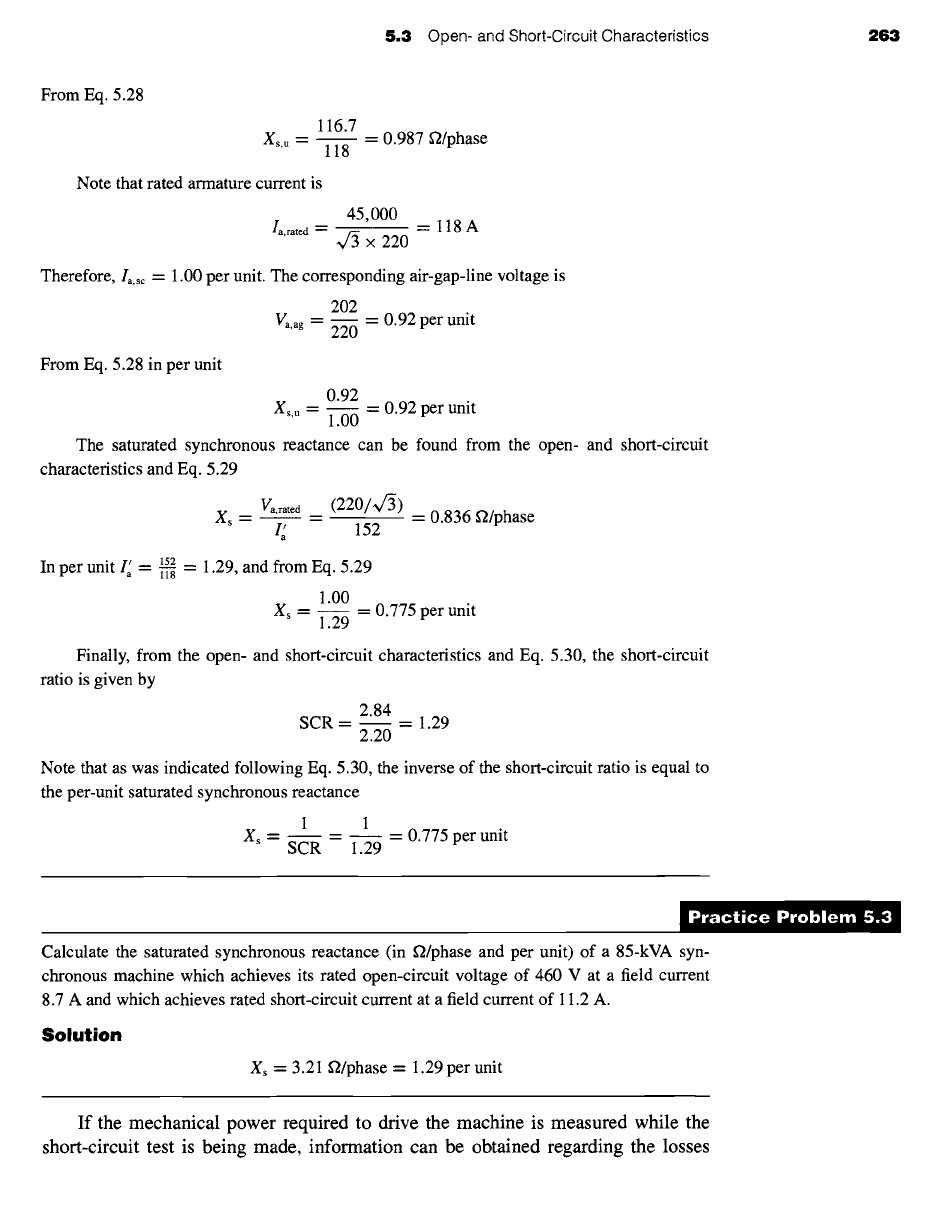
5.3 Open- and Short-Circuit Characteristics
263
From Eq. 5.28
116.7
Xs,u = --0.987 fl/phase
118
Note that rated armature current is
45,000
, = = 118 A
la rated
~ X 220
Therefore, la, sc = 1.00 per unit. The corresponding air-gap-line voltage is
202
Va, ag = 220 = 0.92 per unit
From Eq. 5.28 in per unit
0.92
Xs,u = 1.00 -- 0.92 per unit
The saturated synchronous reactance can be found from the open- and short-circuit
characteristics and Eq. 5.29
Va,rate d
(220/ff3)
Xs = = = 0.836 f2/phase
Ia' 152
In per unit I~ = ~5__~2 = 1.29, and from Eq. 5.29
118
1.00
Xs = 1.29 - 0.775 per unit
Finally, from the open- and short-circuit characteristics and Eq. 5.30, the short-circuit
ratio is given by
2.84
SCR = = 1.29
2.20
Note that as was indicated following Eq. 5.30, the inverse of the short-circuit ratio is equal to
the per-unit saturated synchronous reactance
1 1
Xs = SCR = 1.29 = 0.775 per unit
Calculate the saturated synchronous reactance (in f2/phase and per unit) of a 85-kVA syn-
chronous machine which achieves its rated open-circuit voltage of 460 V at a field current
8.7 A and which achieves rated short-circuit current at a field current of 11.2 A.
Solution
Xs = 3.21 f2/phase = 1.29 per unit
If the mechanical power required to drive the machine is measured while the
short-circuit test is being made, information can be obtained regarding the losses
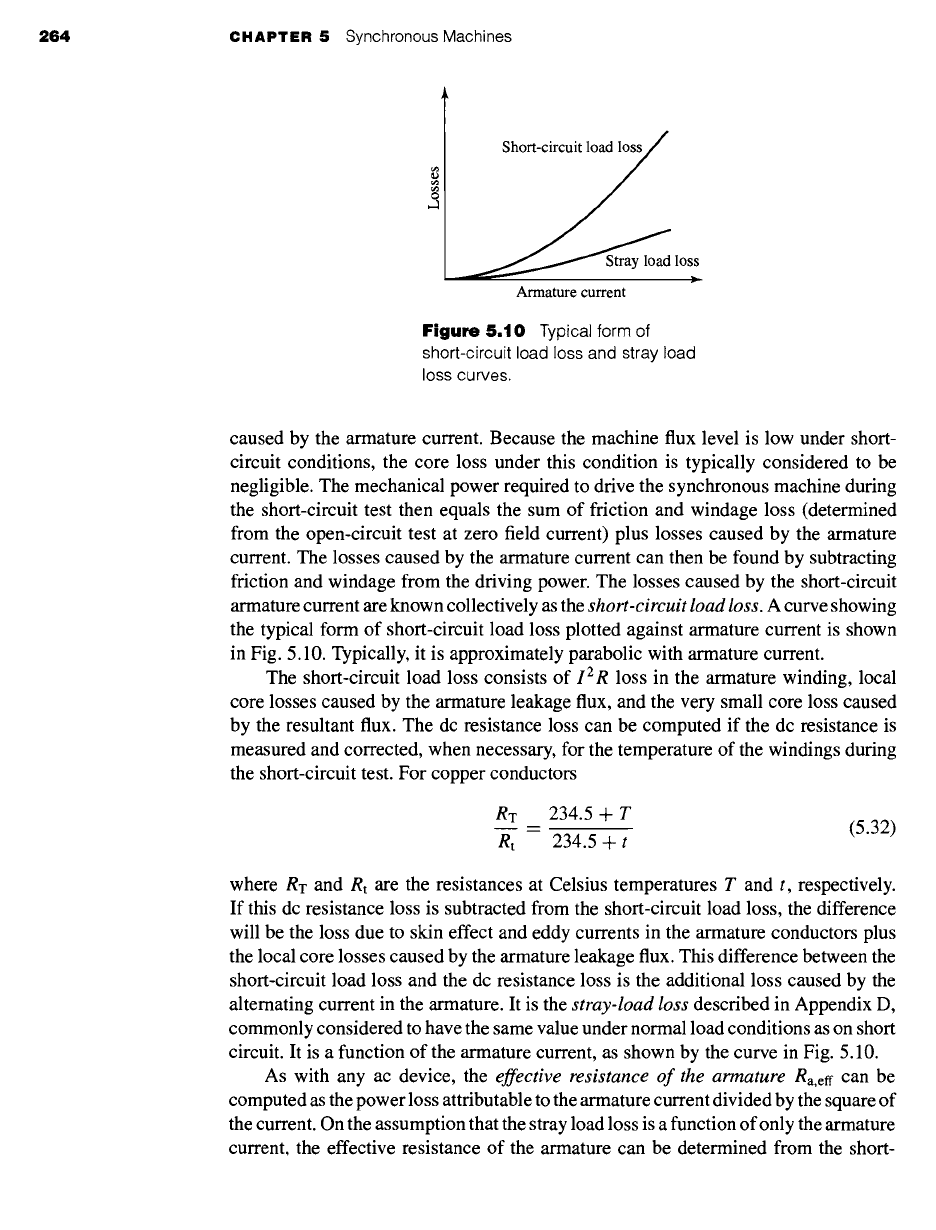
264 CHAPTER 5 Synchronous Machines
~~~~~S~y lo~ loss
Armature current
Figure
5.10 Typical form of
short-circuit load loss and stray load
loss curves.
caused by the armature current. Because the machine flux level is low under short-
circuit conditions, the core loss under this condition is typically considered to be
negligible. The mechanical power required to drive the synchronous machine during
the short-circuit test then equals the sum of friction and windage loss (determined
from the open-circuit test at zero field current) plus losses caused by the armature
current. The losses caused by the armature current can then be found by subtracting
friction and windage from the driving power. The losses caused by the short-circuit
armature current are known collectively as the short-circuit load loss. A curve showing
the typical form of short-circuit load loss plotted against armature current is shown
in Fig. 5.10. Typically, it is approximately parabolic with armature current.
The short-circuit load loss consists of I2R loss in the armature winding, local
core losses caused by the armature leakage flux, and the very small core loss caused
by the resultant flux. The dc resistance loss can be computed if the dc resistance is
measured and corrected, when necessary, for the temperature of the windings during
the short-circuit test. For copper conductors
RT 234.5 + T
= (5.32)
Rt 234.5 + t
where RT and Rt are the resistances at Celsius temperatures T and t, respectively.
If this dc resistance loss is subtracted from the short-circuit load loss, the difference
will be the loss due to skin effect and eddy currents in the armature conductors plus
the local core losses caused by the armature leakage flux. This difference between the
short-circuit load loss and the dc resistance loss is the additional loss caused by the
alternating current in the armature. It is the stray-load loss described in Appendix D,
commonly considered to have the same value under normal load conditions as on short
circuit. It is a function of the armature current, as shown by the curve in Fig. 5.10.
As with any ac device, the effective resistance of the
armature
Ra, eff can be
computed as the power loss attributable to the armature current divided by the square of
the current. On the assumption that the stray load loss is a function of only the armature
current, the effective resistance of the armature can be determined from the short-

5.3 Open- and Short-Circuit Characteristics
265
circuit load loss:
short-circuit load loss
ga,eff = (short-circuit armature current) 2 (5.33)
If the short-circuit load loss and armature current are in per unit, the effective resistance
will be in per unit. If they are in watts per phase and amperes per phase, respectively,
the effective resistance will be in ohms per phase. Usually it is sufficiently accurate
to find the value of Ra, eff at rated current and then to assume it to be constant.
For the 45-kVA, three-phase, Y-connected synchronous machine of Example 5.4, at rated
armature current (118 A) the short-circuit load loss (total for three phases) is 1.80 kW at a
temperature of 25°C. The dc resistance of the armature at this temperature is 0.0335 ~2/phase.
Compute the effective armature resistance in per unit and in ohms per phase at 25°C.
II Solution
The short-circuit load loss is 1.80/45 = 0.040 per unit at la = 1.00 per unit. Therefore,
0.040
ga,eff = (1.00)2
= 0.040 per unit
On a per-phase basis the short-circuit load loss is 1800/3 = 600 W/phase and consequently
the effective resistance is
600
Ra'eff -- (118)
2 - 0.043 f2/phase
The ratio of ac-to-dc resistance is
Ra, eff 0.043
Ra, dc 0.0335
= 1.28
Because this is a small machine, its per-unit resistance is relatively high. The effective
armature resistance of machines with ratings above a few hundred kilovoltamperes usually is
less than 0.01 per unit.
EXAMPLE 5.5
mractice Problem 5.,
Consider a three-phase 13.8 kV 25-MVA synchronous generator whose three-phase short-
circuit loss is 52.8 kW at rated armature current. Calculate (a) its rated armature current and
(b) its effective armature resistance in ~2/phase and in per unit.
Solution
a. 1046 A
b.
Ra, eff --
0.0161 ~/phase = 0.0021 per unit
